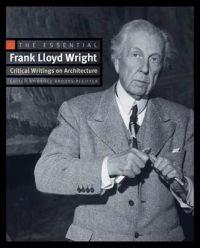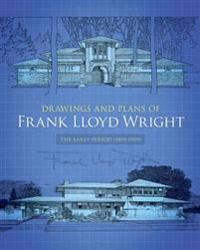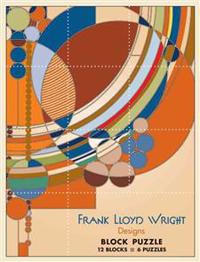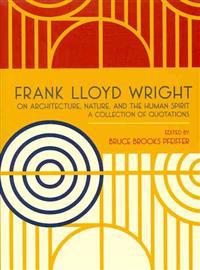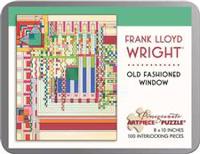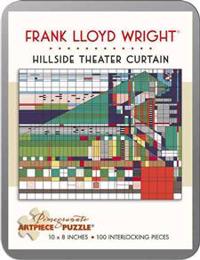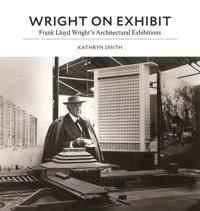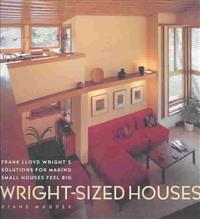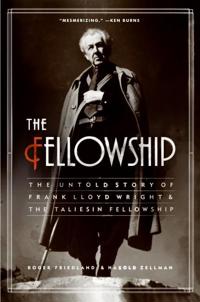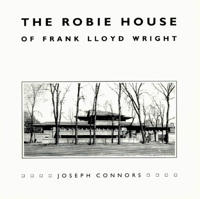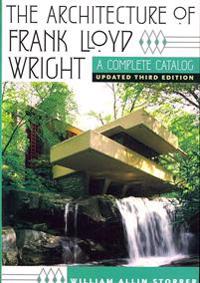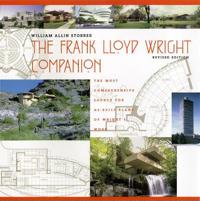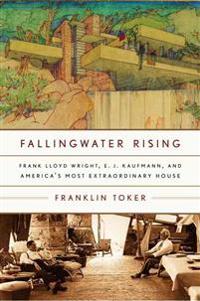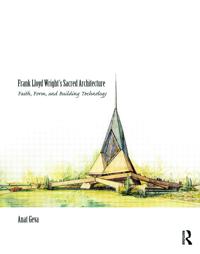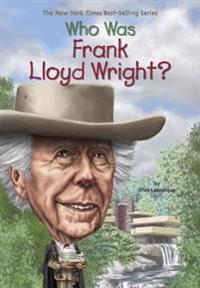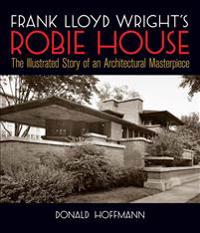The Essential Frank Lloyd Wright (Inbunden)
avFrank Lloyd Wright, Bruce Brooks (EDT) Pfeiffer, Frank Lloyd Wright
ISBN: 9780691133188 - UTGIVEN: 2008-02He was the most iconoclastic of architects, and at the height of his career his output of writings about architecture was as prolific and visionary as his architecture itself. Frank Lloyd Wright pioneered a bold new kind of architecture, one in which the spirit of modern man truly "lived in his buil[...]
Frank Lloyd Wright Domestic Architecture and Objects (Häftad)
avFrank Lloyd Wright
ISBN: 9780471145011 - UTGIVEN: 1995-06-30Drawings and Plans of Frank Lloyd Wright (Häftad)
avFrank Lloyd Wright
ISBN: 9780486244570 - UTGIVEN: 1984-01One of the famed architect's earliest published works, the Wasmuth drawings capture Wright's first great experiments in organic design and thought. These 100 plates were reproduced from a rare 1910 first edition. The full-page illustrations depict plans for homes, banks, cottages, offices, temples, [...]
Frank Lloyd Wright Designs Blo (Övrigt)
avFrank Lloyd Wright
ISBN: 9780764959523 - UTGIVEN: 2011-06Frank Lloyd Wright on Architecture, Nature, and the Human Spirit: A Collection of Quotations (Inbunden)
avFrank Lloyd Wright, Bruce Brooks Pfeiffer
ISBN: 9780764959561 - UTGIVEN: 2011-09Frank Lloyd Wright/Oldfash Window 100 Piece Tin Puzzle (Övrigt)
avFrank Lloyd Wright
ISBN: 9780764964084 - UTGIVEN: 2012-09Frank Lloyd Wright/Theater Curtain 100 Piece Tin Puzzle (Övrigt)
avFrank Lloyd Wright
ISBN: 9780764964091 - UTGIVEN: 2012-09Frank Lloyd Wright Field Guide (Pocket)
avThomas A. Heinz, Frank Lloyd Wright, Thomas A. Heinz
ISBN: 9780810122444 - UTGIVEN: 2005-12Frank Lloyd Wright Field Guide provides the first complete visitors' guide to all of Wright's buildings in the United States and around the world. This new, single-volume edition is written and compiled by architect and Frank Lloyd Wright expert Thomas A. Heinz, AIA. In a highly readable and informa[...]
The Essential Frank Lloyd Wright: Critical Writings on Architecture (Pocket)
avWright, Frank Lloyd
ISBN: 9780691146324 - UTGIVEN: 2010-02-08He was the most iconoclastic of architects, and at the height of his career his output of writings about architecture was as prolific and visionary as his architecture itself. Frank Lloyd Wright pioneered a bold new kind of architecture, one in which the spirit of modern man truly "lived in his buil[...]
Frank Lloyd Wright: An Autobiography (Inbunden)
avWright, Frank L
ISBN: 9780764932434Frank Lloyd Wright exerted perhaps the greatest influence on twentieth century design. In a volume that continues to resonate more than seventy years after its initial publication, Frank Lloyd Wright: An Autobiography contains the master architect's own account of his work, his philosophy, and his p[...]
Wright on Exhibit: Frank Lloyd Wright's Architectural Exhibitions
ISBN: 9780691167220 - UTGIVEN: 2017-04The first history of Frank Lloyd Wright's exhibitions of his own work--a practice central to his careerMore than one hundred exhibitions of Frank Lloyd Wright's work were mounted between 1894 and his death in 1959. Wright organized the majority of these exhibitions himself and viewed them as crucial[...]
Wright-Sized Houses: Frank Lloyd Wright's Solutions for Making Small Houses Feel Big (Inbunden)
avDiane Maddex
ISBN: 9780810946262 - UTGIVEN: 2003-11Offering insight into the famous architect's career-long focus on small, moderate-budget houses, a tour of his small-house designs includes coverage of such structures as the Stockman House, a recently restored Prairie house based on his "Fireproof House for $5,000" design, and the Peterson Cottage.[...]
The Fellowship: The Untold Story of Frank Lloyd Wright and the Taliesin Fellowship (Häftad)
avRoger Friedland, Harold Zellman
ISBN: 9780060988661 - UTGIVEN: 2007-10Frank Lloyd Wright was renowned during his life not only as an architectural genius but also as a subject of controversy--from his radical design innovations to his turbulent private life, including a notorious mass murder that occurred at his Wisconsin estate, Taliesin, in 1914. But the estate also[...]
Frank Lloyd Wright: A Life (Häftad)
ISBN: 9780143114291 - UTGIVEN: 2008-04Pulitzer Prize?winning critic Ada Louise Huxtable's biography of America's greatest architect
Renowned architecture critic Ada Louise Huxtable's biography "Frank Lloyd Wright" looks at the architect and the man, from his tumultuous personal life to his long career as a master builder. Along the[...]The Robie House of Frank Lloyd Wright
ISBN: 9780226115429 - UTGIVEN: 1984-05The Robie House in Chicago is one of the world's most famous houses, a masterpiece from the end of Frank Lloyd Wright's early period and a classic example of the Prairie House. This book is intended as a companion for the visitor to the house, but it also probes beneath the surface to see how the de[...]
The Architecture of Frank Lloyd Wright (Häftad)
avWilliam Allin Storrer
ISBN: 9780226776200 - UTGIVEN: 2007-09Among the many books available on Frank Lloyd Wright, William Allin Storrer's classic "The Architecture of Frank Lloyd Wright: A Complete Catalog" is the authoritative guide to all of Wright's built work. This updated third edition revisits each of Wright's structures, tracing the architect's develo[...]
The Frank Lloyd Wright Companion (Inbunden)
avWilliam Allin Storrer
ISBN: 9780226776217 - UTGIVEN: 2006-11Published to critical acclaim more than a decade ago, "The Frank Lloyd Wright Companion" brought together in one volume all the essential descriptions, photographs, and plans of everything built by America's most famous architect. Now, for this handsomely produced revised edition, William Allin Stor[...]
Frank Lloyd Wright's Monona Terrace
ISBN: 9780299155001 - UTGIVEN: 1999-04With sumptuous illustrations and superb documentation, the extraordinary story of the epic fifty-nine-year civic battle to build one of Frank Lloyd Wright's most important designs is finally told in "Frank Lloyd Wright's Monona Terrace: The Enduring Power of a Civic Vision," by David Mollenhoff and [...]
Fallingwater Rising: Frank Lloyd Wright, E. J. Kaufmann, and America's Most Extraordinary House (Häftad)
avFranklin Toker
ISBN: 9780375710155 - UTGIVEN: 2005-05In this work of popular history at its best, an internationally recognized specialist in the history of architecture pens the biography of the most famous American house of the 20th century: Frank Lloyd Wright's Fallingwater. 150 photos.[...]
Frank Lloyd Wright and Japan (Häftad)
ISBN: 9780415232692 - UTGIVEN: 2000-04This book is the first thorough account of Frank Lloyd Wright's relationship with Japan and its arts. It presents significant new information on the nature and extent of Wright's formal and philosophical debt to Japanese art and architecture. Eight primary channels of influence are examined in detai[...]
Frank Lloyd Wright's Sacred Architecture (Inbunden)
ISBN: 9780415775083 - UTGIVEN: 2011-09A comprehensive study of the sacred buildings built and designed by Frank Lloyd Wright, this book offers scholarly discussion with analytical drawings and photographs. These projects represent different periods of Wright's career (from 1886 to 1958), new building technologies, and application of his[...]
Who Was Frank Lloyd Wright? (häftad)
ISBN: 9780448483139 - UTGIVEN: 2015-12Born in Wisconsin in 1867, Frank Lloyd Wright became obsessed with a set of building blocks his mother had given to him on his ninth birthday. He grew up to become the father of organic architecture and the greatest American architect of all time, having designed more than 1,100 buildings during his[...]
Frank Lloyd Wright: Between Principles and Form (Häftad)
avPaul Laseau
ISBN: 9780471288831 - UTGIVEN: 1991-12-31Frank Lloyd Wright: His Life and His Architecture (Häftad)
avRobert C. Twombly
ISBN: 9780471857976 - UTGIVEN: 1987-06-30

